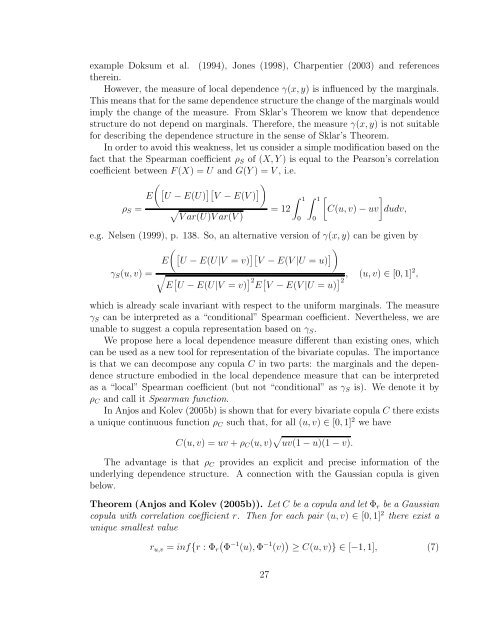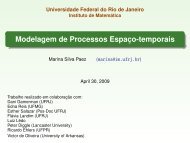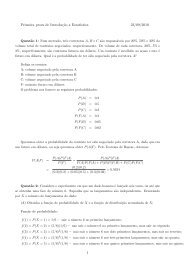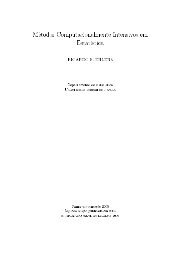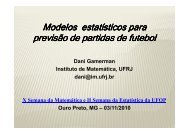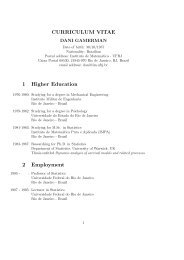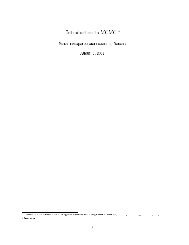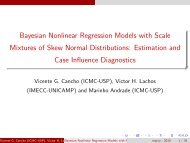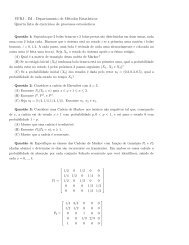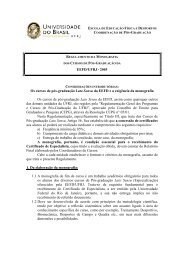Copulas: a Review and Recent Developments (2007)
Copulas: a Review and Recent Developments (2007)
Copulas: a Review and Recent Developments (2007)
You also want an ePaper? Increase the reach of your titles
YUMPU automatically turns print PDFs into web optimized ePapers that Google loves.
example Doksum et al. (1994), Jones (1998), Charpentier (2003) <strong>and</strong> referencestherein.However, the measure of local dependence °(x; y) is in°uenced by the marginals.This means that for the same dependence structure the change of the marginals wouldimply the change of the measure. From Sklar's Theorem we know that dependencestructure do not depend on marginals. Therefore, the measure °(x; y) is not suitablefor describing the dependence structure in the sense of Sklar's Theorem.In order to avoid this weakness, let us consider a simple modi¯cation based on thefact that the Spearman coe±cient ½ S of (X; Y ) is equal to the Pearson's correlationcoe±cient between F (X) =U <strong>and</strong> G(Y )=V ,i.e.µ £U ¤£ ¤ E ¡ E(U) V ¡ E(V ) Z 1 Z 1·¸½ S = p =12 C(u; v) ¡ uv dudv;Var(U)Var(V )e.g. Nelsen (1999), p. 138. So, an alternative version of °(x; y) canbegivenbyµ £U ¤£ ¤ E ¡ E(UjV = v) V ¡ E(V jU = u)° S (u; v) = qE £ U ¡ E(UjV = v) ¤ 2 £ ¤ ; (u; v) 2 [0; 1] 2 ;2E V ¡ E(V jU = u)00which is already scale invariant with respect to the uniform marginals. The measure° S can be interpreted as a \conditional" Spearman coe±cient. Nevertheless, we areunable to suggest a copula representation based on ° S .We propose here a local dependence measure di®erent than existing ones, whichcan be used as a new tool for representation of the bivariate copulas. The importanceis that we can decompose any copula C in two parts: the marginals <strong>and</strong> the dependencestructure embodied in the local dependence measure that can be interpretedas a \local" Spearman coe±cient (but not \conditional" as ° S is). We denote it by½ C <strong>and</strong> call it Spearman function.In Anjos <strong>and</strong> Kolev (2005b) is shown that for every bivariate copula C there existsa unique continuous function ½ C such that, for all (u; v) 2 [0; 1] 2 we haveC(u; v) =uv + ½ C (u; v) p uv(1 ¡ u)(1 ¡ v):The advantage is that ½ C provides an explicit <strong>and</strong> precise information of theunderlying dependence structure. A connection with the Gaussian copula is givenbelow.Theorem (Anjos <strong>and</strong> Kolev (2005b)). Let C beacopula<strong>and</strong>let© r be a Gaussiancopula with correlation coe±cient r. Then for each pair (u; v) 2 [0; 1] 2 there exist aunique smallest valuer u;v = inffr :© r¡© ¡1 (u); © ¡1 (v) ¢ ¸ C(u; v)g 2[¡1; 1]; (7)27


